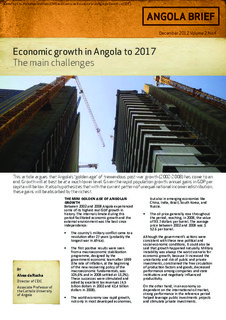| dc.contributor.author | da Rocha, Alves | |
| dc.date.accessioned | 2018-01-04T08:18:36Z | |
| dc.date.available | 2018-01-04T08:18:36Z | |
| dc.date.issued | 2012-12-11 | |
| dc.identifier | oai:www.cmi.no:4669 | |
| dc.identifier.citation | Bergen: Chr. Michelsen Institute (Angola Brief vol. 2 no. 4) 4 p. | |
| dc.identifier.issn | 1892-3933 | |
| dc.identifier.uri | http://hdl.handle.net/11250/2474890 | |
| dc.description.abstract | This article argues that Angola’s “golden age” of tremendous post-war growth (2002-2008) has come to an end. Growth will at best be at a much lower level. Given the rapid population growth, annual gains in GDP per capita will be low. It also hypothesizes that with the current pattern of unequal national income redistribution, these gains will be absorbed by the richest. | |
| dc.language.iso | eng | |
| dc.publisher | Chr. Michelsen Institute | |
| dc.relation | Angola Brief | |
| dc.relation | 4 | |
| dc.relation.ispartof | Angola Brief | |
| dc.relation.ispartofseries | Angola Brief vol. 2 no. 4 | |
| dc.relation.uri | https://www.cmi.no/publications/4669-economic-growth-in-angola-to-2017 | |
| dc.subject | Angola | |
| dc.title | Economic growth in Angola to 2017: The main challenges | |
| dc.type | Report | |
